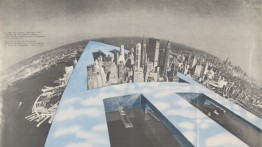Drawing Ambience: Panel Discussion
Friday, November 6, 2015, 6:30 - 6:30pm

Superstudio, New-New York, 1969. © Superstudio.
In conjunction with the exhibition Drawing Ambience: Alvin Boyarsky and the Architectural Association, please join our distinguished scholars in a lively conversation about the education and practice of architecture, and the evolving role of drawing within the discipline. Speakers will include Nicholas Boyarsky, Robin Middleton, Joan Ockman, Bernard Tschumi, Anthony Vidler, Michael Webb and Dean Nader Tehrani.
On Education and Practice
The AA of the 1970s and 1980s, much like The Cooper Union, was a critical and cultural project: autonomous in many ways from the mainstream profession but also often in an antagonistic relationship with it. It was also critical of post modernism in architecture and of the sterility of late modernism. This was a very specific moment in time when architectural ideas were discussed and developed through a vast range of media within the context of the architectural school. Drawing was one – and probably the most powerful – means of expression. Within this realm, the Architectural Association’s intellectual debate, publications, exhibitions and installations are both remarkable and worthy of comparison to today’s situation.
Given the impact of current architectural practice on technological research and development, what kind of impact do the conceptual challenges, especially those of more speculative practices, have on architectural education now? Does the current form of practice ultimately inform pedagogical objectives, or is it a one-way relationship?
What is the intellectual project of the academy today? How have perceptions of the role of autonomy shifted to include social and political constructs that offer both ideological freedom and concrete aspects of technology? To what degree are questions of climate change, resilience, massive migration, flexibility, and economy – among other urgencies – becoming drivers of architecture’s social relevance?
On Drawing
One could argue that the critical role of the school of architecture, the intellectual project, is to redefine the profession, in part by expanding its horizons and also by critical example. Representation is one of the key tools here, specifically the drawing. A drawing has a complex function. It is an expression of cognitive-thinking, a key to the exposure of realities hidden, to the revelation of data and to the possibilities of re-conceiving the world.
Alvin Boyarsky often referred to drawings at the AA as a polemical tool: “We fight our battles with the drawings on the wall.” During the two decades covered by the Drawing Ambience exhibition there are a number of developing tendencies, from the photomontages of Superstudio and Coop Himmelblau, to the more poetic and crafted drawings of Peter Salter or Peter Wilson, to the highly skilled constructed perspectives and isometrics of Zaha Hadid and OMA. All of these works reveal and share the development of hard won critical architectural voices, each with their own polemical position.
Today, media is everywhere; it is instrumentalized by all parties in key ways, both critically and commercially. In this climate, how can architecture ask more difficult questions through its means and methods of representation? How can our instruments of drawing, which are ever more complex today, be seen as rarefied tools? To what extent has the drawing been subsumed into the digital realm and the architectures of software, and to what extent can it remain independent? If drawing was once about speculating on and defining one’s architectural position, what future role can the digital have within the culture of the critical drawing? Or is the critical drawing no longer relevant, to be replaced with the drawing as the instrumental tool used for prototyping?
Drawing Ambience highlights the collection of drawings assembled by the late Alvin Boyarsky during his pivotal tenure as chairman of the Architectural Association (AA) in London. Boyarsky argued that architecture was not only a profession but also an artistic venture—a practice that comprises drawing and publication as much as it engages design and construction. During his time leading the school, he orchestrated an ambitious exhibition and publication program, a sister to the exhibition and publication program simultaneously being developed at The Irwin S. Chanin School of Architecture by late Dean John Hejduk, that situated drawing as not only a representational tool, but as a form of architecture in its own right. Drawing Ambience explores Boyarsky’s role as a collector of drawings and also, metaphorically speaking, of the ideas and people that have come to define a key moment in architectural history.
This exhibition was originally shown at the Mildred Lane Kemper Art Museum at Washington University in St. Louis and the RISD Museum, co-organizers of the exhibit. It was co-curated by Jan Howard, Chief Curator and Houghton P. Metcalf Jr. Curator of Prints, Drawings, and Photographs at the RISD Museum, and Igor Marjanović, Associate Professor of Architecture at the Sam Fox School of Design & Visual Arts, Washington University. An exhibition catalogue of the same title is currently being distributed by the University of Chicago Press.
Located in The Great Hall, in the Foundation Building, 7 East 7th Street, between Third and Fourth Avenues




